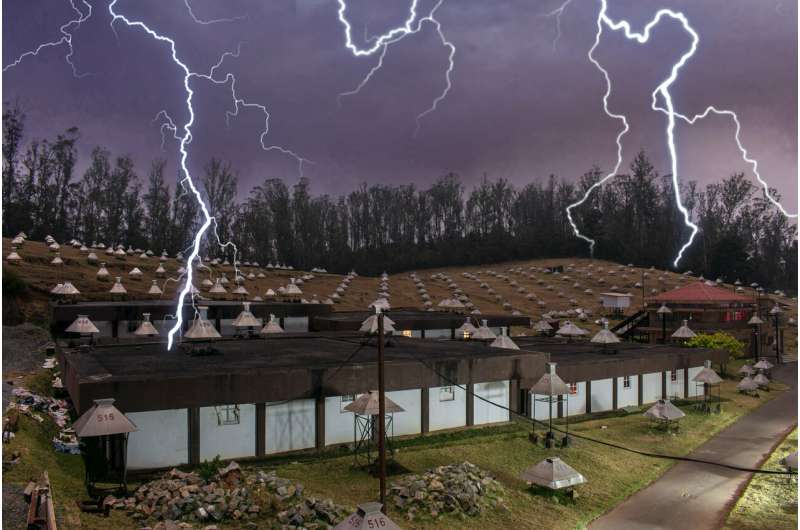March 19, 2019 report
Researchers use muon detector to measure electric potential in a thunderstorm

A team of researchers from several institutions in India and Japan has found that it is possible to use a muon detector to measure electric potential in thunderstorms. The paper is published in the journal Physical Review Letters. The researchers explain that they noticed muon detection levels drop during thunderstorms, and used that information to calculate electric potential in thunderstorms.
Lightning bolts that flash across the sky are ample evidence that storms produce electricity. Over the past several decades, scientists have sent balloons and planes into storms to learn more about what goes on inside of them. But the sensors used in such efforts have only been able to capture data about very small parts of storms. In this new effort, the researchers developed a way to capture one critical measurement of an entire storm—its electric potential.
The electric potential of a storm is defined as the collective amount of work that would be required to move its electrons from one part of a cloud to another. In thunderstorms, the electric potential arises as positively charged water droplets rise and negatively charged droplets sink, and the air between them becomes conductive. Because of their electrical activity, thunderstorms can have an impact on muons, forcing them to lose energy, which prevents muon detectors from detecting them.
Muons are one of a type of tiny particles that result when cosmic particles slam into the atmosphere and break apart into millions of bits of debris—they constantly rain down from above. Scientists have built muon detectors to study them. One such facility is the GRAPES-3, located in India. It has 400 muon detectors located on the ground, covering approximately 25,000 square meters. Together, they detect millions of muons every minute. The researchers with this new effort began monitoring changes in detection levels when they noticed that the levels fell when thunderstorms were overhead. They report that they monitored and studied changes to such levels over the time period April 2011 to December 2014. During one particularly large storm that occurred on December 1, 2014, muon levels dropped a full 2 percent.

As part of their research, the team built a storm simulator to calculate the total electrical potential of a storm based on the drop in muons detected. They report that their simulator showed the December storm had a 1.3-billion-volt electric potential.
More information: B. Hariharan et al. Measurement of the Electrical Properties of a Thundercloud Through Muon Imaging by the GRAPES-3 Experiment, Physical Review Letters (2019). DOI: 10.1103/PhysRevLett.122.105101
Journal information: Physical Review Letters
© 2019 Science X Network





















